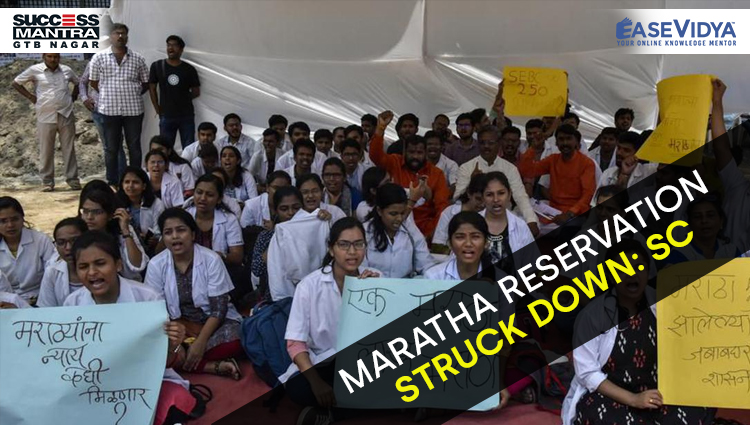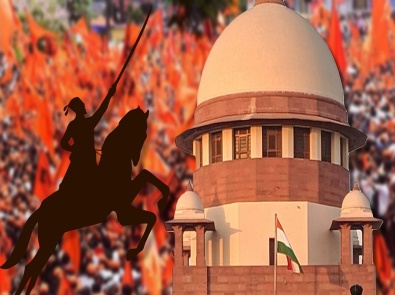
MARATHA RESERVATION STRUCK DOWN: SC
MARATHA RESERVATION STRUCK DOWN: SC

Recently, the Supreme Court (SC) declared a Maharashtra law which provides reservation benefits to the Maratha community, taking the quota limit in the State in excess of 50%, as unconstitutional.
BACKGROUND OF THE ISSUE
- 2017: A 11-member commission headed by Retired Justice N G Gaikwad recommended Marathas should be given reservation under Socially and Educationally Backward Class (SEBC).
- 2018: Maharashtra Assembly passed a Bill proposing 16% reservation for Maratha community.
- 2018: The Bombay High Court while upholding the reservation pointed out that instead of 16% it should be reduced to 12% in education and 13%in jobs.
- 2020: The SC stayed its implementation and referred the case to Chief Justice of India for a larger bench.
CURRENT RULING OF THE SUPREME COURT
Violation of Fundamental Rights: A separate reservation for the Maratha community violates Articles 14 (right to equality) and 21 (due process of law). Reservation breaching the 50% limit will create a society based on “caste rule”. The Maratha reservation of 12% and 13% (in education and jobs) had increased the overall reservation ceiling to 64% and 65%, respectively. In the Indira Sawhney judgment 1992, SC had categorically said 50% shall be the rule, only in certain exceptional and extraordinary situations for bringing far-flung and remote areas' population into mainstream said 50% rule can be relaxed.
No Further Benefits: Appointments made under the Maratha quota following the Bombay High Court judgment endorsing the State law would hold, but they would get no further benefits.
Deprived States of the Power to Identify SEBCs: There will only be a single list of SEBC with respect to each State and Union Territory notified by the President of India, and that States can only make recommendations for inclusion or exclusion, with any subsequent change to be made only by Parliament. The Bench unanimously upheld the constitutional validity of the 102nd Constitution Amendment but differed on the question whether it affected the power of states to identify SEBCs.
Direction to NCBC: Asked the National Commission for Backward Classes (NCBC) to expedite the recommendation of SEBCs so that the President can publish the notification containing the list of SEBCs in relation to States and Union Territories expeditiously.
102nd Amendment Act of 2018
It introduced Articles 338B and 342A in the Constitution. Article 338B deals with the newly established National Commission for Backward Classes. Article 342A empowers the President to specify the socially and educationally backward communities in a State. It says that it is for the Parliament to include a community in the Central List for socially and backward classes for grant of reservation benefits.
CONSTITUTION & RESERVATIONS PROVISION
77th Constitutional Amendment Act, 1995: The Indra Sawhney verdict had held there would be reservation only in initial appointments and not promotions. However, addition of the article 16(4A) to the Constitution, empowered the state to make provisions for reservation in matters of promotion to SC/ST employees, if the state feels they are not adequately represented.
81st Constitutional Amendment Act, 2000: It introduced Article 16(4B), which says unfilled SC/ST quota of a particular year, when carried forward to the next year, will be treated separately and not clubbed with the regular vacancies of that year.
85th Constitutional Amendment Act, 2001: It provided for the reservation in promotion can be applied with ‘consequential seniority’ for the government servants belonging to the SCs and STs with retrospective effect from June 1995.
102nd, 103rd and 104th Amendments: In the last couple of decades, there have been several amendments to the constitution like the 102nd amendment, 104th amendment. 10% reservation for EWS. was made by the 103rd amendment to the Constitution.
Article 335: It says that the claims of SCs and STs shall be taken into consideration constituently with the maintenance of efficacy of the administration.
1992 JUDGEMENT & STATE'S ADHERENCE

Indra Sawhney & Others vs Union of India, 1992: The judgement on Indra Sawhney case was passed on 16 November, 1992. It was a nine-judge verdict which decisively laid down several landmark propositions such as 50% threshold in reservations. It said, ”Reservation being an extreme form of protective measure should be confined to a minority of seats even though the constitution does not lay down any specific bar, the principle of balancing equality; reservation of any manner shall not exceed 50%”. The concept of ‘creamy layer’ also gained importance through this judgment and provision that reservation for backward classes should be confined to initial appointments only and not extend to promotions. Earlier, the reservation was meant to be only for SCs and STs. It was the Mandal Commission case that brought Other Backward Classes (OBCs) under reserved category.
Adherence of the Limit by the States: Notwithstanding the judgement passed by the Supreme Court, since 1992, many states have passed laws breaching this limit of 50% such as Maharashtra, Telangana, Rajasthan and Madhya Pradesh. Besides, Tamil Nadu, Haryana and Chhattisgarh, have also passed similar laws, causing them to exceed the 50% reservation mark. The apex court has decided to look into Tamil Nadu’s 69% quota law after deciding the Maratha quota case. The 69% quota in the state pre-dates the Indra Sawhney judgement. In January 2000, the Governor of the erstwhile state of Andhra Pradesh declared 100% reservation to Scheduled Tribes (ST) candidates in posts of school teachers in Scheduled Areas. However, it was ruled as unconstitutional by the apex court.
50% Reservation Not a Law: Although the limit of 50% is not set by any statute but it is laid down by the apex court and hence was binding to all the authorities. However, the judgement itself said that in exceptional circumstances, the percentage can be increased. The issue that arises with the ‘exceptional circumstance’ is that if it actually exists in a given case or not and if yes then by how much can the limit exceed.
TEST YOURSELF
1. The Supreme Court (SC) declared a Maharashtra law which provides reservation benefits to the Maratha community, taking the quota limit in the State in excess of 50%, as unconstitutional because it violates ___________?
- Article 12 & 14
- Article 14 & 21
- Article 14 & 19
- None of the following
Q.2 Which of the following statements is/are incorrect in the reference to the Supreme Court reviewing the 50% Cap on reservation?
- A Five-judge bench at the Supreme Court has decided to examine whether the 1992 verdict of capping quota at 50% (S.R. Bommai v. Union of India)
- The court’s observation came in a case where a reservation for Marathas in Maharashtra caused a breach in the 50% ceiling.
- The review will be related to the extension of the creamy layer concept not just to OBC but also Schedule Caste (SC) and Schedule Tribe (ST).
- None of the above
Q.3 Which of the following Articles of Indian Constitution is not matched correctly with their laid provisions?
- Article 338-I: National Commission for Scheduled Tribes
- Article 330: Reservation of seats for Scheduled Castes and Scheduled Tribes in Lok Sabha
- Article 333: Representation of the people of the Anglo-Indian community in the Legislative Assemblies of the States
- Article 331: National Commission for Scheduled Castes
Q.4 Consider the following statements & state which of the following is correct in the context of the landmark judgment of 'Indra Sawhney v. Union of India'?
- P. V. Narasimha Rao government decided to implement the recommendations of the Mandal Commission, and made 27% reservations for Other Backward Classes (OBCs)
- Earlier, the reservation was meant to be only for SCs and STs but after this case the Other Backward Classes (OBCs) was brought under the reserved category.
- Only I follows
- Only II follows
- Both I & II are correct
- None is correct
Q.5 Which of the Constitutional Amendment Act empowers the state to provide up to 10% reservation in education and public employment for “economically weaker sections” (EWS)?
- 62nd Constitutional Amendment Act
- 93rd Constitutional Amendment Act
- 103rd Constitutional Amendment Act
- None of the above












0 Comment